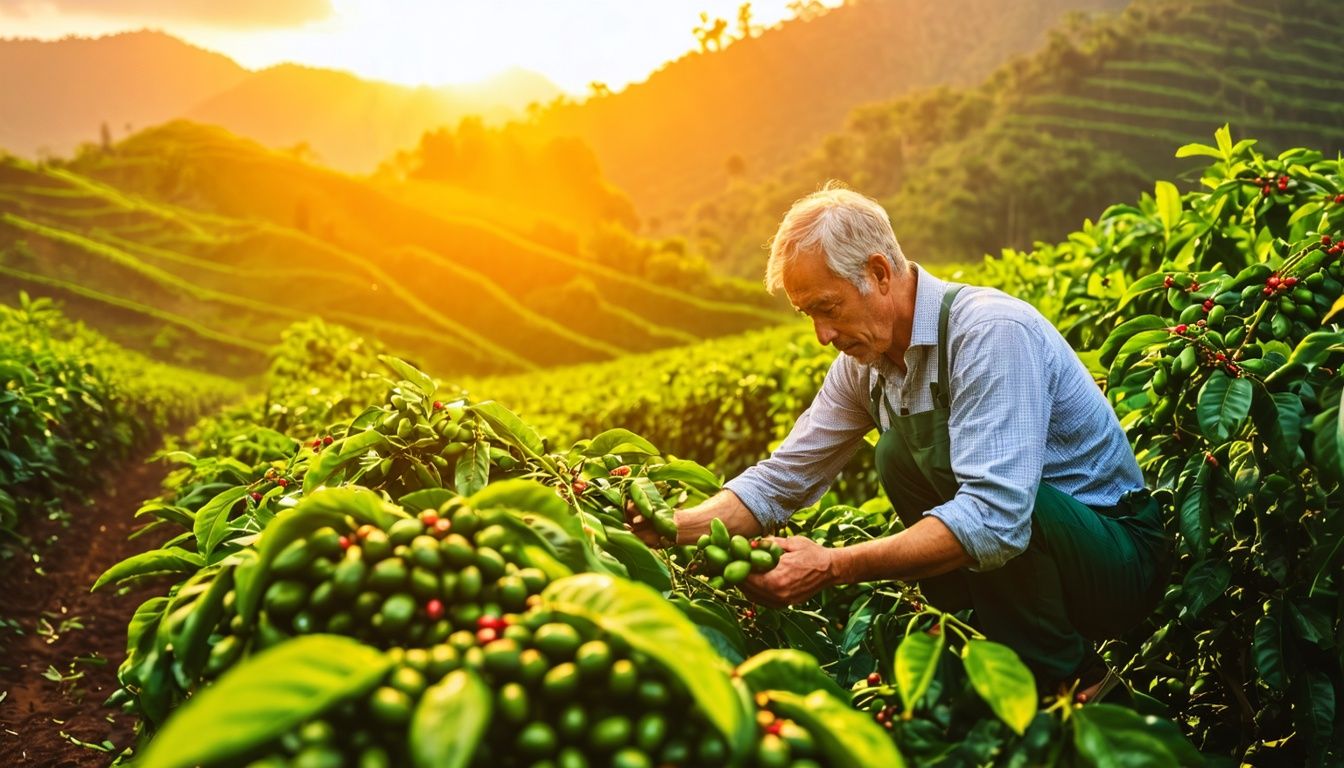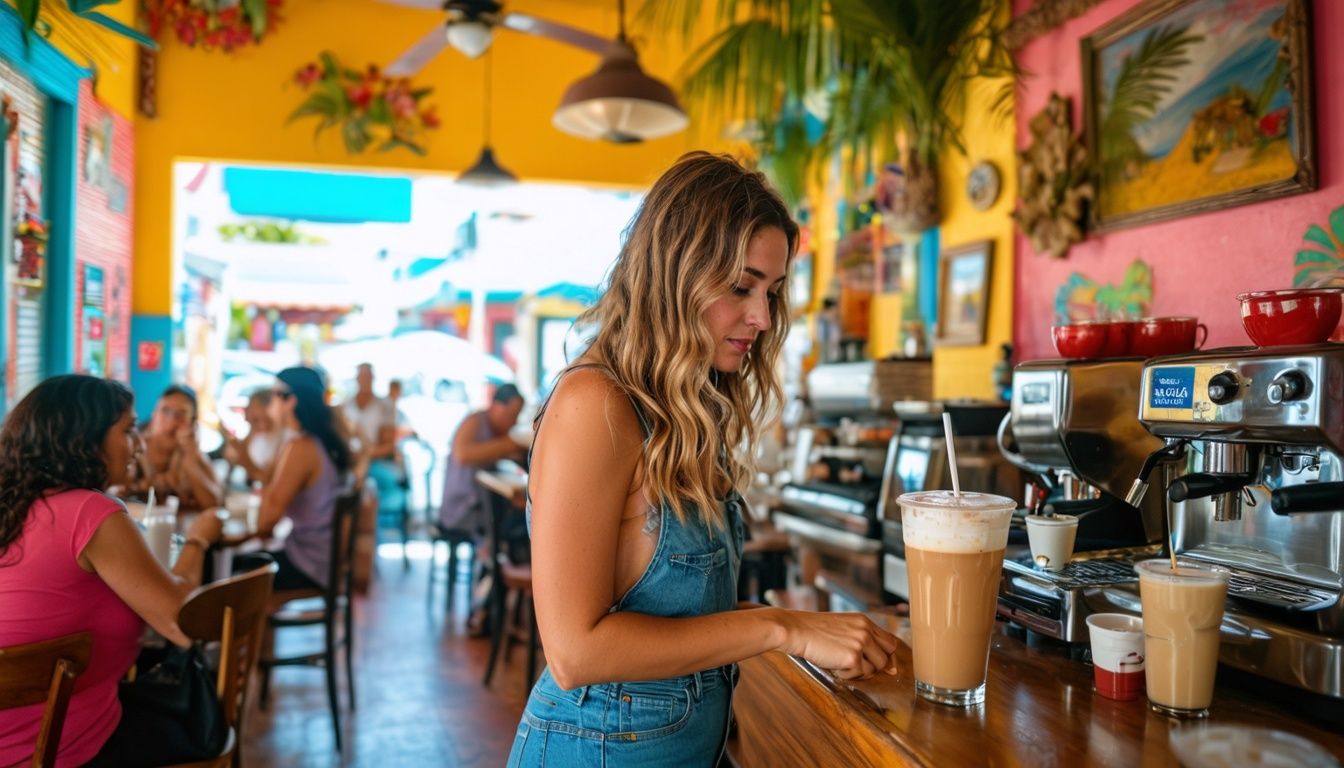Blog
Uncovering The Rich History Of Coffee: A Journey Through The Origins And Evolution
You’ve likely sipped coffee countless times, but have you ever wondered about its origins? Coffee’s journey spans centuries and continents, yet its rich history remains a mystery to many.
Coffee’s roots trace back to Ethiopia, where legend says a goatherd discovered its energising effects. Today, you’ll explore coffee’s evolution from ancient times to modern day. You’ll uncover how this humble bean transformed cultures and economies worldwide.
Ready for a caffeine-fuelled adventure?
The Ethiopian Legend Behind Coffee’s Discovery

Legend tells of Kaldi, a 9th-century Ethiopian goatherd, who discovered coffee. His goats ate berries from a certain tree and became energetic, dancing around. Kaldi tried the berries himself and felt their stimulating effects.
He shared his find with local monks, who created a drink from the berries to stay alert during prayers.
Coffee’s origins trace back to wild Coffea species in Ethiopia‘s Kefa region. Somali merchants from Berbera and Zeila exported coffee from Ethiopia to Yemen. Ethiopian languages use “buna,” “bun,” “būn,” or “buni” for coffee, derived from Arabic “bunn” or possibly Cushitic languages.
Coffee’s Pioneering Journey to the Arabian Peninsula

Coffee’s journey to the Arabian Peninsula marked a pivotal moment in its history. You’ll find that by the 15th century, coffee cultivation had taken root in southern Arabia. Sufi monasteries in Yemen embraced coffee as an aid to concentration during prayers, sparking its spread across the region.
The port of Mocha became a key hub for coffee trade, connecting Africa to the wider world.
In 1414, coffee reached Mecca, quickly gaining popularity. Its influence expanded to Egypt and North Africa in the early 1500s. You’d see coffeehouses popping up across cities, becoming centres for social gatherings and intellectual discussions.
The Ottoman Empire played a crucial role in coffee’s expansion, with Constantinople (modern-day Istanbul) emerging as a major coffee trading centre. This period set the stage for coffee’s global journey, transforming it from a local beverage to an international commodity.
Establishing the Coffee Tradition in the Ottoman Empire

Ottoman Empire embraced coffee culture with gusto. In the mid-16th century, Istanbul saw its first coffeehouse open, sparking a social revolution. You’d find these establishments bustling with intellectuals, artists, and merchants – all sipping the dark brew.
Despite initial resistance from conservative imams who banned coffee in Mecca in 1511, Sultan Suleiman I overturned this decision in 1524. The beverage’s popularity soared, spreading to Cairo and Aleppo.
Yet, controversy persisted. In 1532, Cairo authorities sacked coffeehouses and warehouses, viewing them as hotbeds of dissent. This turbulent period shaped coffee’s role in Ottoman society, cementing its status as a symbol of intellectual discourse and social bonding.
Coffee’s Arrival and Expansion in Europe

Coffee’s arrival in Europe sparked a cultural revolution. Italian merchants introduced the beverage to Venice in the 16th century, establishing Europe’s first coffeehouse in 1645. You’d find these establishments quickly becoming hubs of intellectual discourse and social interaction.
Paris embraced coffee in 1669, thanks to Mr. Thevenot and Soleiman Agha. The drink’s popularity exploded across the continent, with England boasting over 3,000 coffeehouses by 1675.
You’d witness coffee transforming social norms, fuelling debates, and shaping the economic landscape of major European cities.
Trade routes played a crucial role in coffee’s European expansion. Venetian traders brought beans from the Middle East, introducing Italians to this exotic brew. You’d see coffeehouses popping up in major port cities, then spreading inland.
These venues offered a sober alternative to taverns, attracting intellectuals, businessmen, and artists. In just a century, coffee had become an integral part of European daily life, influencing everything from social customs to political movements.
The Proliferation of Coffee Across the Americas

You’ll find the Americas’ coffee story fascinating. Gabriel de Clieu brought coffee seedlings to Martinique in 1720, sparking a revolution. These tiny plants flourished, spreading rapidly across the Caribbean.
By 1788, the French territory of Saint-Domingue supplied half the world’s coffee – a staggering feat.
Brazil’s coffee industry took root after 1822, thanks to Francisco de Melo Palheta. His efforts transformed Brazil into a coffee powerhouse. The Boston Tea Party of 1773 shifted American tastes.
You’d see colonists ditching tea for coffee, a trend that stuck. This pivotal moment cemented coffee’s place in American culture. The beans’ journey through the Americas changed global trade and tastes forever.
The Cultivation and Influence of Coffee in Asia
 Coffee’s journey to Asia began in the 17th century. Baba Budan brought it to India in 1670, sparking a new era. Dutch traders introduced it to Indonesia, now a major producer. Japan embraced coffee through Dutch influence, boasting 30,000 cafes by the 1930s.
Coffee’s journey to Asia began in the 17th century. Baba Budan brought it to India in 1670, sparking a new era. Dutch traders introduced it to Indonesia, now a major producer. Japan embraced coffee through Dutch influence, boasting 30,000 cafes by the 1930s.
Vietnam’s coffee boom started post-1995. Trade normalisation with the US fuelled rapid growth. Asian countries transformed from importers to global coffee powerhouses. Their unique cultivation methods and flavour profiles reshaped the industry.
Supplementary Insights on Coffee’s Historical Journey

Coffee’s journey through history is rich with tales from various cultures. You’ll find fascinating stories about how coffee shaped societies in the UK, France, Italy, and the Netherlands, as well as its growth in India and Japan.
The Role of Coffee in the United Kingdom and France
Coffee’s impact on the UK and France was profound. In 1652, Pasqua Rosee opened London’s first coffeehouse, sparking a cultural revolution. These establishments quickly became hubs for intellectual discourse and business dealings.
King Charles II’s ministers tried to suppress coffeehouses in 1675, fearing their influence.
France embraced coffee culture in 1669 when Mr. Thevenot and Soleiman Agha introduced it to Paris. French coffeehouses, like their British counterparts, became centres of enlightenment and political debate.
However, Britain’s coffee consumption declined after Haiti’s coffee industry collapsed, leading to a shift towards tea drinking.
The Coffee Cultures of Italy and the Netherlands
Italy’s coffee culture centres around the espresso, born with the invention of the espresso machine in 1901. You’ll find Italians savouring quick shots at the bar, often paired with pastries.
The moka pot, created by Alfonso Bialetti in 1933, brought espresso-style coffee into Italian homes.
Dutch coffee culture, in contrast, stems from their colonial past. In 1616, the Dutch obtained live coffee trees, establishing cultivation in their colonies. This move made the Netherlands a key player in the global coffee trade.
You’ll notice a more relaxed approach to coffee drinking in Dutch cafes, with longer, leisurely sessions common.
The Growth of Coffee in India and Japan
Coffee reached India in 1670, thanks to Baba Budan. You’ll find over 250,000 growers today, mainly in South India. The industry has flourished, with plantations dotting the lush hills of Karnataka, Kerala, and Tamil Nadu.
Japan’s coffee journey began in the 17th century, introduced by Dutch traders. By the early 1930s, you’d see over 30,000 coffeehouses across the country. This rapid growth transformed Japan’s beverage culture, blending traditional tea ceremonies with modern coffee rituals.
The Role of Coffee in Colonial Expansion

Coffee fuelled colonial expansion in the 18th and 19th centuries. European powers sought new territories to cultivate this lucrative crop. In 1720, Gabriel de Clieu brought coffee seedlings to Martinique, kickstarting Caribbean production.
By 1788, the French colony of Saint-Domingue supplied half the world’s coffee. This rapid growth relied on slave labour and exploitation of local resources.
Post-1822, Brazil emerged as a major coffee producer thanks to Francisco de Melo Palheta’s efforts. European demand for coffee led to extensive plantations in Latin America and Africa.
These operations often displaced indigenous peoples and exploited workers, sparking uprisings. The coffee trade shaped global economics, with European companies controlling production and distribution in colonised regions.
The Historical Development of Coffeehouses

Coffeehouses, or “qahveh khaneh“, emerged in Near Eastern cities as vibrant social hubs. You’d find these establishments bustling with patrons engaged in lively discussions, chess matches, and music performances.
In 17th-century England, coffeehouses became epicentres of political and financial activity, shaping public opinion and fostering intellectual discourse.
Austria’s first coffeehouse opened in 1683, sparking a unique Viennese coffee culture in the 19th century. You’d experience a similar trend in New Amsterdam (later New York) during the mid-1600s, where coffeehouses gained popularity after the Boston Tea Party.
These establishments served as meeting places for business, politics, and social interaction, cementing coffee’s role in shaping modern society.
Trends Shaping Modern Coffee Culture
Modern coffee culture has shifted towards sustainability and unique experiences. You’ll find an increased focus on ethically sourced, fair-trade beans as consumers demand transparency in the supply chain.
Specialty coffees and artisanal brewing methods have gained popularity, with pour-over and cold brew becoming staples in many cafes.
The rise of third-wave coffee shops has transformed the industry. These establishments emphasise quality, origin, and craft, offering single-origin beans and expert baristas. You’ll also notice a surge in plant-based milk alternatives and innovative flavour combinations.
Global warming poses a threat to coffee production, pushing the industry to adopt climate-resilient practices and explore new growing regions.
The Economic Impact of the Coffee Industry
Coffee’s economic impact is staggering. In 2022, the US coffee industry contributed £343.2 billion to the economy—a 52.4% jump from 2015. You’ll find coffee’s influence extends far beyond your morning cuppa.
It’s the second most sought commodity after crude oil, shaping global trade patterns. The industry fuels job creation too, supporting over 2.2 million US jobs.
Your coffee habit plays a significant role in the economy. In 2022, consumers splashed out nearly £110 billion on coffee. This spending ripples through the supply chain, from farmers to baristas.
The industry’s growth shows no signs of slowing, with new coffee shops and roasters popping up regularly. E-commerce platforms have further boosted sales, making speciality coffees more accessible to you.
Conclusion
You’ve journeyed through coffee’s rich past, from Ethiopian legends to global dominance. This aromatic beverage shaped cultures, economies, and social interactions worldwide. Implement your newfound knowledge to appreciate your next cup’s centuries-old heritage.
Explore artisanal roasts or visit historic cafes to deepen your connection with coffee’s legacy. Your coffee experience will never be the same – savour every sip of this remarkable brew.
FAQs
Where did coffee originate?
Coffee’s roots trace back to the Ethiopian Highlands. Legend attributes its discovery to a goatherd. The energising berries soon spread to Yemen, then across the Red Sea.
How did coffee influence European culture?
Coffee houses opened in Venice, becoming hubs for news and social gatherings. They quickly spread across Europe, sparking intellectual discussions and shaping social norms.
When did coffee reach the New World?
The British East India Company brought coffee to the Americas in the 17th century. Plantations soon flourished in Central America and Colombia, transforming economies.
What role did religion play in coffee’s spread?
Initially controversial in Islam, coffee gained acceptance. Pope Clement VIII’s approval boosted its popularity in Catholic regions. Some viewed it as an alternative to alcohol.
How has coffee preparation evolved?
From simple brewing to French presses, coffee prep has diversified. Instant coffee, perfected in the early 1900s, revolutionised consumption. Now, artisanal methods are popular.
Which countries are top coffee producers today?
Brazil leads global production, followed by Vietnam and Colombia. Ethiopia, coffee’s birthplace, remains a significant producer of prized Arabica beans.
References
- special-e-1the_palace_and_the_coffeehouse.pdf
- https://www.researchgate.net/publication/378317359
- https://www.researchgate.net/publication/348540346
- https://www.researchgate.net/publication/366823851
- GEHNWP04ST.pdf
- 223201571.pdf
- https://www.ncausa.org/Research-Trends/Economic-Impact



